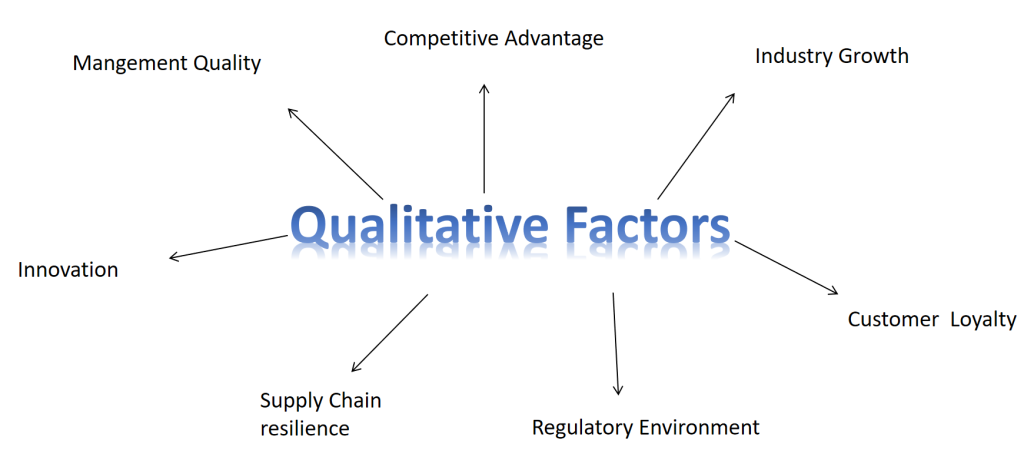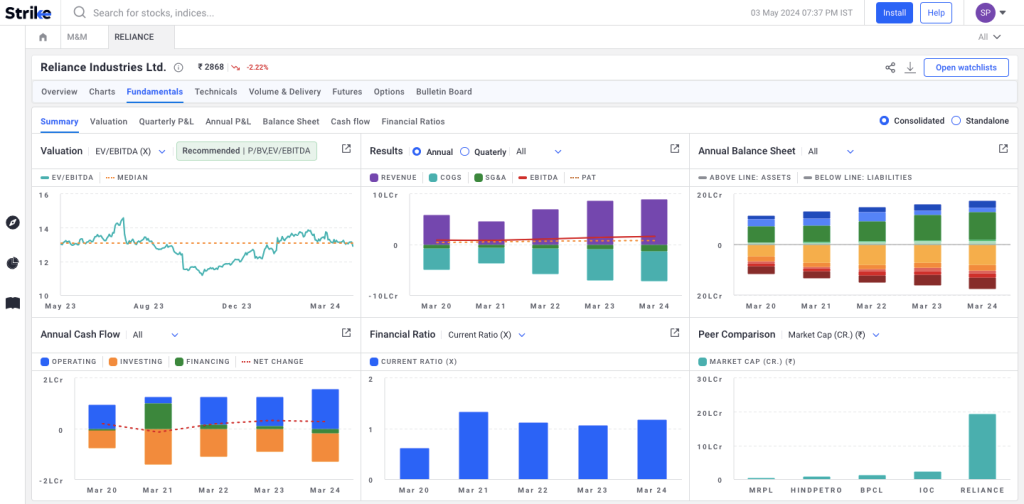Global: fundamental analysis globally
Lernziele der Lektion:
- Understand qualitative factors that influence company success. Learn how aspects like management quality, industry position, brand strength, Und innovation can affect a company’s ability to succeed and grow. These elements help identify companies with strong future prospects, even if they are not easily measured by numbers.
- Explore quantitative factors that assess a company’s financial health. This includes metrics like revenue growth, earnings per share (EPS), P/E ratio, Und return on equity (ROE), which provide measurable indicators of a company’s profitability and overall financial stability.
- Learn the impact of regulatory and political factors on companies. Understand how the regulatory environment and political stability can influence the long-term success of businesses in Europe, and how to assess these factors when making investment decisions.
- Learn how to use both qualitative and quantitative data to assess investment opportunities. You will understand how to combine both types of analysis to get a clearer picture of a company’s potential for long-term growth and sustainability.
A. Qualitative Factors
Qualitative factors in fundamental analysis are non-numeric elements that affect a company’s long-term prospects. These aspects are often subjective but provide valuable insight into a company’s potential for success or failure.
- Managementqualität: The leadership and decision-making abilities of a company’s management team can significantly influence its performance. Companies with experienced, visionary leaders tend to outperform those with weak or inconsistent management.
- Beispiel: Companies like Apple under Steve Jobs or Tesla under Elon Musk benefited from strong, innovative leadership that drove growth.
- Beispiel: Companies like Apple under Steve Jobs or Tesla under Elon Musk benefited from strong, innovative leadership that drove growth.
- Industry Position: A company’s competitive position within its industry can determine its ability to maintain market share and grow. Companies that are leaders in their sectors often have strong brands, loyal customers, and economies of scale that provide a competitive edge.
- Beispiel: Amazon dominates the e-commerce sector due to its vast infrastructure and market presence.
- Beispiel: Amazon dominates the e-commerce sector due to its vast infrastructure and market presence.
- Brand Strength: A strong brand can provide a company with pricing power, customer loyalty, and resilience during market downturns. Companies with well-established brands tend to have more consistent revenues and customer loyalty.
- Beispiel: Coca-Cola has one of the most valuable brands in the world, giving it a competitive advantage in the beverage industry.
- Beispiel: Coca-Cola has one of the most valuable brands in the world, giving it a competitive advantage in the beverage industry.
- Innovation and Intellectual Property: Companies that invest in innovation and own valuable intellectual property (IP) are often well-positioned for future growth. Patents, proprietary technologies, and research and development (R&D) capabilities can set a company apart from its competitors.
- Beispiel: Pfizer Und Moderna leveraged their IP in vaccine development, leading to significant growth during the COVID-19 pandemic.
- Beispiel: Pfizer Und Moderna leveraged their IP in vaccine development, leading to significant growth during the COVID-19 pandemic.
- Regulatorisches Umfeld: The regulatory landscape in which a company operates can impact its growth potential and profitability. For instance, companies in highly regulated industries like finance, healthcare, or energy may face more obstacles to growth.
- Beispiel: Pharmaceutical companies must navigate complex regulations regarding drug approvals, which can slow down growth or create barriers to entry.

Figur: Qualitative Faktoren, die den Wettbewerbsvorteil beeinflussen
Beschreibung:
Die Abbildung zeigt verschiedene qualitative Faktoren, die für den Wettbewerbsvorteil eines Unternehmens entscheidend sind. Dazu gehören Managementqualität, Branchenwachstum, Innovation, Kundentreue, die Belastbarkeit der Lieferkette und das regulatorische Umfeld. Jedes dieser Elemente trägt zur Gesamtstärke und Positionierung eines Unternehmens in seiner Branche bei.
Die zentralen Thesen:
- Managementqualität: Das Fachwissen, die Erfahrung und die Effektivität des Führungsteams eines Unternehmens.
- Branchenwachstum: Das Expansions- und Rentabilitätspotenzial innerhalb der Branche.
- Innovation: The company’s ability to introduce new products, services, or processes.
- Kundentreue: Das Ausmaß, in dem Kunden den Produkten oder Dienstleistungen eines Unternehmens treu bleiben.
- Widerstandsfähigkeit der Lieferkette: Die Robustheit der Lieferkette eines Unternehmens gegenüber Störungen.
- Regulatorisches Umfeld: Die Auswirkungen staatlicher Vorschriften auf die Geschäftstätigkeit eines Unternehmens.
Anwendung der Informationen:
Understanding these qualitative factors is essential for investors and stakeholders to gauge a company’s potential for sustained competitive advantage. A firm that excels in these areas is likely to be more resilient to market challenges, adapt to changing industry dynamics, and maintain a strong position in its market segment. By focusing on these qualitative aspects, investors can make more informed decisions about the long-term viability and growth potential of a company.
B. Quantitative Factors
Quantitative factors are objective, data-driven elements that reflect a company’s financial performance. These factors are derived from financial statements, providing measurable indicators of a company’s profitability, liquidity, and overall financial health.
- Revenue Growth: Revenue indicates the total income generated by a company’s operations. Steady revenue growth is a sign that a company is expanding its customer base or increasing its sales per customer.
- Beispiel: A company that reports consistent year-over-year revenue growth is likely in a strong financial position.
- Beispiel: A company that reports consistent year-over-year revenue growth is likely in a strong financial position.
- Earnings Per Share (EPS): EPS measures a company’s profitability on a per-share basis and is calculated by dividing net income by the total number of outstanding shares. A growing EPS indicates that the company is generating higher profits for its shareholders.
- Beispiel: If a company’s EPS increases over time, it suggests that it is becoming more profitable.
- Beispiel: If a company’s EPS increases over time, it suggests that it is becoming more profitable.
- Price-to-Earnings (P/E) Ratio: The P/E ratio compares a company’s current share price to its earnings per share. It’s used to assess whether a stock is overvalued or undervalued compared to its peers or the broader market.
- Beispiel: A lower P/E ratio may suggest a stock is undervalued, whereas a high P/E ratio might indicate overvaluation.
- Beispiel: A lower P/E ratio may suggest a stock is undervalued, whereas a high P/E ratio might indicate overvaluation.
- Price-to-Book (P/B) Ratio: The P/B ratio compares a company’s market value to its book value (assets minus liabilities). A lower P/B ratio can indicate that a stock is undervalued relative to its assets.
- Beispiel: A P/B ratio below 1 might signal a buying opportunity for value investors.
- Beispiel: A P/B ratio below 1 might signal a buying opportunity for value investors.
- Debt-to-Equity (D/E) Ratio: This ratio compares a company’s total debt to its shareholder equity and is used to assess financial leverage. A lower D/E ratio indicates that a company is using less debt to finance its operations, which can be a sign of financial stability.
- Beispiel: Companies with a low D/E ratio are less risky, especially in times of economic uncertainty.
- Beispiel: Companies with a low D/E ratio are less risky, especially in times of economic uncertainty.
- Return on Equity (ROE): ROE measures a company’s profitability relative to shareholder equity. It’s an indicator of how effectively management is using the company’s assets to generate profits.
- Beispiel: A higher ROE suggests that the company is efficient at generating returns for shareholders.
- Beispiel: A higher ROE suggests that the company is efficient at generating returns for shareholders.
- Free Cash Flow (FCF): FCF represents the cash a company generates after accounting for capital expenditures. It’s a key metric for assessing financial health because it shows how much cash is available for dividends, debt repayment, or reinvestment.
- Beispiel: Consistently positive FCF indicates that a company is financially healthy and capable of supporting growth initiatives or returning capital to shareholders.
Figur: Fundamental Analysis Dashboard for Reliance Industries Ltd.
Beschreibung:
This figure presents a dashboard showcasing the Fundamentalanalyse of Reliance Industries Ltd., focusing on key metrics like valuation, financial results, balance sheet, cash flow, Und financial ratios. The valuation chart displays the EV/EBITDA trend, indicating market valuation changes over time. Other charts cover metrics like annual revenue, cost of goods sold (COGS), Rentabilität, liquidity ratios, Und peer comparisons. It provides a holistic view of the company’s financial health.
Die zentralen Thesen:
- EV/EBITDA helps assess Reliance’s market valuation relative to its earnings before interest, taxes, depreciation, and amortization.
- Der balance sheet analysis highlights asset distribution and liabilities, offering insights into financial stability.
- Cash flow components help identify operating, investing, and financing activities over time.
- Liquidity ratios, such as the current ratio, reveal short-term financial health.
- Peer comparison aids in understanding Reliance’s position within the industry.
Anwendung der Informationen:
Investors can use this dashboard to conduct a thorough Fundamentalanalyse of Reliance Industries Ltd., evaluating its finanzielle Gesundheit, Rentabilität, Und market competitiveness. This analysis helps users make informed decisions on whether to buy, hold, or sell the stock based on financial metrics, historical performance, and peer standing.
Abschluss
Beide qualitativ Und quantitative factors play a vital role in fundamental analysis, providing a holistic view of a company’s financial health and growth potential. While qualitative factors like management quality, brand strength, Und industry position offer insights into a company’s market standing, quantitative factors such as revenue growth, P/E ratio, Und free cash flow provide objective measures of performance. By combining these approaches, investors can make more informed decisions and build stronger, more resilient portfolios.
Wichtige Unterrichtsinformationen:
- Management quality is crucial for a company’s long-term success. A company led by strong, visionary leaders tends to outperform its competitors. Leaders who can navigate challenges, innovate, and drive growth can significantly impact a company’s performance. Strong management is often a predictor of future success.
- Industry position and brand strength are key to maintaining a competitive edge. Companies that dominate their sectors, like Amazon or Coca-Cola, benefit from strong customer loyalty and economies of scale, which help them grow and withstand market downturns. A powerful brand provides resilience during tough times.
- Innovation and intellectual property give companies a competitive advantage. Companies that invest in research and development (R&D) and hold valuable intellectual property (IP) are more likely to thrive in the long term. For example, Pfizer and Moderna’s focus on innovative vaccine development during the COVID-19 pandemic led to substantial growth.
- Quantitative metrics like revenue growth, EPS, and P/E ratio provide clear insights into a company’s financial health. These data points reflect a company’s profitability, efficiency, and market valuation. Regular revenue growth signals a company is expanding, while increasing EPS shows improved profitability.
- The regulatory environment and political stability in Europe can affect business growth. Companies that operate in highly regulated sectors may face more barriers to growth, but those that navigate these regulations successfully can demonstrate resilience and attract investors. Additionally, understanding political stability helps mitigate risks related to geopolitical shifts.
Schlusserklärung:
Understanding both qualitative and quantitative factors in fundamental analysis is essential for evaluating investment opportunities. By focusing on management, innovation, financial health, and regulatory factors, investors can gain a deeper understanding of a company’s long-term growth potential and make well-informed decisions.


